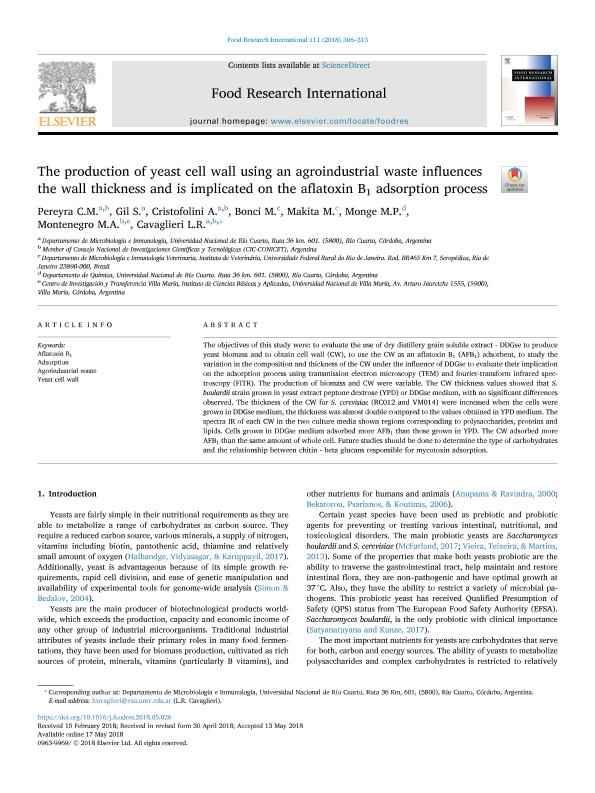Mostrar el registro sencillo del ítem
dc.contributor.author
Pereyra, Carina Maricel

dc.contributor.author
Gil, Samanta Soledad

dc.contributor.author
Cristofolini, Andrea Lorena

dc.contributor.author
Bonci, Mário
dc.contributor.author
Makita, Mário
dc.contributor.author
Monge, Maria del Pilar

dc.contributor.author
Montenegro, Mariana Angélica

dc.contributor.author
Cavaglieri, Lilia Reneé

dc.date.available
2022-08-04T14:52:40Z
dc.date.issued
2018-09
dc.identifier.citation
Pereyra, Carina Maricel; Gil, Samanta Soledad; Cristofolini, Andrea Lorena; Bonci, Mário; Makita, Mário; et al.; The production of yeast cell wall using an agroindustrial waste influences the wall thickness and is implicated on the aflatoxin B1 adsorption process; Elsevier Science; Food Research International; 111; 9-2018; 306-313
dc.identifier.issn
0963-9969
dc.identifier.uri
http://hdl.handle.net/11336/164216
dc.description.abstract
The objectives of this study were: to evaluate the use of dry distillery grain soluble extract - DDGse to produce yeast biomass and to obtain cell wall (CW), to use the CW as an aflatoxin B1 (AFB1) adsorbent, to study the variation in the composition and thickness of the CW under the influence of DDGse to evaluate their implication on the adsorption process using transmission electron microscopy (TEM) and fourier-transform infrared spectroscopy (FITR). The production of biomass and CW were variable. The CW thickness values showed that S. boulardii strain grown in yeast extract peptone dextrose (YPD) or DDGse medium, with no significant differences observed. The thickness of the CW for S. cerevisiae (RC012 and VM014) were increased when the cells were grown in DDGse medium, the thickness was almost double compared to the values obtained in YPD medium. The spectra IR of each CW in the two culture media shown regions corresponding to polysaccharides, proteins and lipids. Cells grown in DDGse medium adsorbed more AFB1 than those grown in YPD. The CW adsorbed more AFB1 than the same amount of whole cell. Future studies should be done to determine the type of carbohydrates and the relationship between chitin - beta glucans responsible for mycotoxin adsorption.
dc.format
application/pdf
dc.language.iso
eng
dc.publisher
Elsevier Science

dc.rights
info:eu-repo/semantics/openAccess
dc.rights.uri
https://creativecommons.org/licenses/by-nc-nd/2.5/ar/
dc.subject
ADSORPTION
dc.subject
AFLATOXIN B1
dc.subject
AGROINDUSTRIAL WASTE
dc.subject
YEAST CELL WALL
dc.subject.classification
Micología

dc.subject.classification
Ciencias Biológicas

dc.subject.classification
CIENCIAS NATURALES Y EXACTAS

dc.title
The production of yeast cell wall using an agroindustrial waste influences the wall thickness and is implicated on the aflatoxin B1 adsorption process
dc.type
info:eu-repo/semantics/article
dc.type
info:ar-repo/semantics/artículo
dc.type
info:eu-repo/semantics/publishedVersion
dc.date.updated
2022-08-03T18:15:43Z
dc.journal.volume
111
dc.journal.pagination
306-313
dc.journal.pais
Países Bajos

dc.journal.ciudad
Ámsterdam
dc.description.fil
Fil: Pereyra, Carina Maricel. Consejo Nacional de Investigaciones Científicas y Técnicas. Centro Científico Tecnológico Conicet - Córdoba; Argentina. Provincia de Buenos Aires. Gobernación. Comisión de Investigaciones Científicas; Argentina. Universidad Nacional de Río Cuarto. Facultad de Ciencias Exactas, Fisicoquímicas y Naturales. Departamento de Microbiología e Inmunología; Argentina
dc.description.fil
Fil: Gil, Samanta Soledad. Consejo Nacional de Investigaciones Científicas y Técnicas. Centro Científico Tecnológico Conicet - Córdoba; Argentina. Universidad Nacional de Río Cuarto. Facultad de Ciencias Exactas, Fisicoquímicas y Naturales. Departamento de Microbiología e Inmunología; Argentina
dc.description.fil
Fil: Cristofolini, Andrea Lorena. Consejo Nacional de Investigaciones Científicas y Técnicas. Centro Científico Tecnológico Conicet - Córdoba; Argentina. Provincia de Buenos Aires. Gobernación. Comisión de Investigaciones Científicas; Argentina. Universidad Nacional de Río Cuarto. Facultad de Ciencias Exactas, Fisicoquímicas y Naturales. Departamento de Microbiología e Inmunología; Argentina
dc.description.fil
Fil: Bonci, Mário. Universidade Federal Rural do Rio de Janeiro; Brasil
dc.description.fil
Fil: Makita, Mário. Universidade Federal Rural do Rio de Janeiro; Brasil
dc.description.fil
Fil: Monge, Maria del Pilar. Consejo Nacional de Investigaciones Científicas y Técnicas. Centro Científico Tecnológico Conicet - Córdoba; Argentina. Universidad Nacional de Río Cuarto. Facultad de Ciencias Exactas Fisicoquímicas y Naturales. Departamento de Química; Argentina
dc.description.fil
Fil: Montenegro, Mariana Angélica. Consejo Nacional de Investigaciones Científicas y Técnicas. Centro Científico Tecnológico Conicet - Córdoba. Centro de Investigaciones y Transferencia de Villa María. Universidad Nacional de Villa María. Centro de Investigaciones y Transferencia de Villa María; Argentina. Provincia de Buenos Aires. Gobernación. Comisión de Investigaciones Científicas; Argentina. Universidad Nacional de Villa María. Instituto Académico Pedagógico de Ciencias Básicas y Aplicadas; Argentina
dc.description.fil
Fil: Cavaglieri, Lilia Reneé. Consejo Nacional de Investigaciones Científicas y Técnicas. Centro Científico Tecnológico Conicet - Córdoba; Argentina. Provincia de Buenos Aires. Gobernación. Comisión de Investigaciones Científicas; Argentina. Universidad Nacional de Río Cuarto. Facultad de Ciencias Exactas, Fisicoquímicas y Naturales. Departamento de Microbiología e Inmunología; Argentina
dc.journal.title
Food Research International

dc.relation.alternativeid
info:eu-repo/semantics/altIdentifier/doi/http://dx.doi.org/10.1016/j.foodres.2018.05.026
dc.relation.alternativeid
info:eu-repo/semantics/altIdentifier/url/https://www.sciencedirect.com/science/article/pii/S096399691830382X
Archivos asociados
